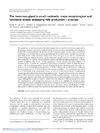Identificador persistente para citar o vincular este elemento:
https://accedacris.ulpgc.es/jspui/handle/10553/46079
| Título: | The mammary gland in small ruminants: Major morphological and functional events underlying milk production - A review | Autores/as: | Lérias, Joana R. Hernández Castellano, Lorenzo Enrique Suárez Trujillo, Aridany Castro Navarro, Noemí Pourlis, Aris Frixos Almeida, André M. |
Clasificación UNESCO: | 3104 Producción Animal 310404 Cuidado y Explotación 310407 Ovinos |
Palabras clave: | Thrice-Daily Milking Recombinant Bovine Somatotropin Conjugated Linoleic-Acid Growth-Hormone Short-Communication, et al. |
Fecha de publicación: | 2014 | Editor/a: | 0022-0299 | Publicación seriada: | Journal of Dairy Research | Resumen: | The importance of small ruminants to the dairy industry has increased in recent years, especially in developing countries, where it has a high economic and social impact. Interestingly and despite the fact that the mammary gland is the specialised milk production organ, very few authors studied the modifications occurring in the mammary gland through the lactation period in production animals, particularly in the small ruminants, sheep (Ovis aries) and goat (Capra hircus). Nevertheless, understanding the different mammary gland patterns throughout lactation is essential to improve dairy production. In addition, associating these patterns with different milking frequencies, lactation number or different diets is also of high importance, directly affecting the dairy industry. The mammary gland is commonly composed of parenchyma and stroma, which includes the ductal system, with individual proportions of each changing during the different periods and yields in a lactation cycle. Indeed, during late gestation, as well as during early to mid-lactation, mammary gland expansion occurs, with an increase in the number of epithelial cells and lumen area, which leads to increment of the parenchyma tissue, as well as a reduction of stroma, corresponding macroscopically to the increase in mammary gland volume. Throughout late lactation, the mammary gland volume decreases owing to the regression of the secretory structure. In general, common mammary gland patterns have been shown for both goats and sheep throughout the several lactation stages, although the number of studies is limited. The main objective of this manuscript is to review the colostrogenesis and lactogenesis processes as well as to highlight the mammary gland morphological patterns underlying milk production during the lactation cycle for small ruminants, and to describe potential differences between goats and sheep, hence contributing to a better description of mammary gland development during lactation for these two poorly studied species. | URI: | https://accedacris.ulpgc.es/handle/10553/46079 | ISSN: | 0022-0299 | DOI: | 10.1017/S0022029914000235 | Fuente: | Journal Of Dairy Research [ISSN 0022-0299], v. 81 (3), p. 304-318 |
| Colección: | Reseña |
Citas SCOPUSTM
77
actualizado el 08-jun-2025
Citas de WEB OF SCIENCETM
Citations
78
actualizado el 12-ene-2026
Visitas
44
actualizado el 11-ene-2026
Descargas
50
actualizado el 11-ene-2026
Google ScholarTM
Verifica
Altmetric
Comparte
Exporta metadatos
Los elementos en ULPGC accedaCRIS están protegidos por derechos de autor con todos los derechos reservados, a menos que se indique lo contrario.
